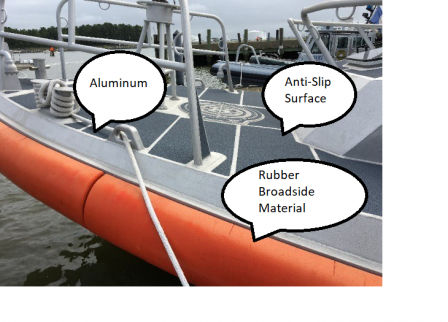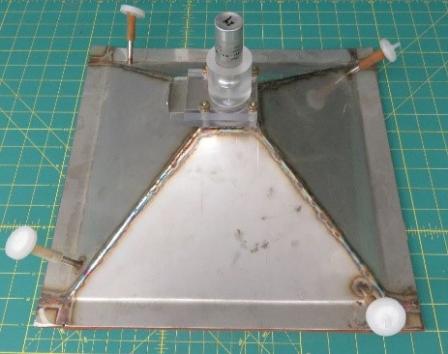Assessment of Effective Decontamination Options for Urban and Maritime Structures and Surfaces Relevant to United States Coast Guard (USCG) Assets
Over the past several years, EPA, in partnership with the Department of Homeland Security Science and other federal partners, states and local governments, has been evaluating strategies and tactics for responding to an intentional release of Bacillus anthracis (Ba). Significant progress has been made in developing methods to respond to indoor contamination incidents, particularly for relatively contained incidents (e.g., single facilities).
In case of a wide-area release of Ba at a port city, the USCG would likely be the lead federal agency for the response activities. Therefore, this project evaluated gross-physical and chemical-based decontamination methods for the USCG structures or assets contaminated with B. anthracis (Ba) spores. The project is performed in the laboratory using laboratory-scale materials and B. globigii as a non-pathogenic biological surrogate of Ba.
The objectives of this study were to:
- Evaluate the effects of using seawater on chlorine disinfectant-based decontamination solutions.
- Evaluate the efficacy of various types of wash-down waters to mechanically remove spores from selected surface materials.
- Evaluate the surface decontamination efficacy of multi-step decontamination methods to remove spores from selected surface and outdoor materials.
Materials selected for this study are commonly found on USCG vessels and stations.These include aluminum, aluminum with antiskid coating, concrete, rubber broadside covering and treated wood.  Vessel Materials Selected for StudyDisinfectant solutions studied included pH amended bleach, and high-test hypochlorite with an added degreasing detergent, which is the decontamination solution specified for use on larger USCG cutters.
Vessel Materials Selected for StudyDisinfectant solutions studied included pH amended bleach, and high-test hypochlorite with an added degreasing detergent, which is the decontamination solution specified for use on larger USCG cutters.
Objective 1: Evaluate the effects of using seawater on chlorine disinfectant-based decontamination.
To achieve the first objective, four water types were tested to determine their impact on a pH-amended bleach disinfectant solution. The water types consisted of:
- distilled water - control
- tap water - control
- surrogate sea water
- surrogate brackish water (10:1 tap/sea water)
- surrogate sea water contaminated with petroleum product and heavy metals, as might be found in a USCG harbor
Disinfectant solutions were made using an 8:1:1 ratio of each water type, germicidal bleach and 5% acidic acid. The target concentration of free available chlorine and pH were 6500 ppm and 6.5–7, respectively. After measuring the solutions for free available chlorine and pH, the ratios needed to be adjusted. To achieve the desired parameters, 20% more bleach needed to be added to the control waters; 25% more bleach to the sea and brackish water and 35% to the “harbor” water.
Preliminary results* indicate no significant differences in the stability of free available chlorine or pH in the amended bleach solutions made from the various source waters. The tests did not consider material demand from organic matter that would be present in actual sea water.
Objective 2: Evaluate the efficacy of various types of water wash-down to mechanically remove spores from selected surface materials.
To accomplish this objective, 14” × 14” coupons (samples) of stainless steel (control), aluminum and rubber were inoculated with a minimum of 1 × 106 spores of B. globigii and allowed to settle overnight (minimum of 18 hours). The coupons were then rinsed with the various water types (tap, seawater and brackish water) for 5 seconds per coupon using copious amounts of water sprayed onto the surface using a garden hose. After drying, coupons were sampled using polyester rayon blend prewetted wipes.  Device Used to Inoculate the Coupons
Device Used to Inoculate the Coupons
Preliminary results suggest that this gross decon method achieved less than one-log reduction of spores on the aluminum coupons and between one and two-log reduction on rubber. No significant difference in spore removal was observed between use of the different water types.
Objective 3: Evaluate the surface decontamination efficacy of multi-step decontamination methods to remove spores from selected surface and outdoor materials.
To achieve this goal, 14” × 14” coupons of all five test materials were utilized as well as stainless steel as control coupons. Two decontamination procedures were evaluated. Procedure 1 including a pre-rinse per the procedure used under objective 2 followed by the application of pH amended bleach and a post rinse. Procedure 2 did not employ the pre-rinse. Simulated sea water was used for the pre- and post-rinse. The formulation for the pH amended bleach was determined under objective one.
The coupons were inoculated with a minimum of 1 × 106 spores of spores of B. globigii and allowed to settle for at least 18 hours. Procedure 1 coupons were given a pre-rinse for 5 seconds per coupon and allowed 30 minutes processing time. Both procedure 1 and procedure 2 coupons were then sprayed with pH amended bleach using a backpack sprayer and allowed 15 minutes processing time. A second application of amended bleach was applied and given 15 minutes processing time (total 30-minute decontamination time), after which a water rinse was applied. Spray Chamber
Spray Chamber
Coupons dried overnight before being sampled with pre-wetted polyester rayon blend wipes.
Preliminary results of the amended bleach decontamination test indicate that a three- to six-log reduction may be achieved on the tested materials, although, the results for rubber are not yet available. The pre-rinse appeared to have been instrumental in achieving no viable spores on most surface.
The same evaluation with and without the pre-rinse were repeated using high-test hypochlorite solution. Greater than six-log reduction was observed on most tested materials, with viable spores detected only on the antiskid material.
This research will continue using coupons of additional materials and different gross decontamination approaches such as high pressure washing; however, the research is on hold due to priority COVID-19 research.
